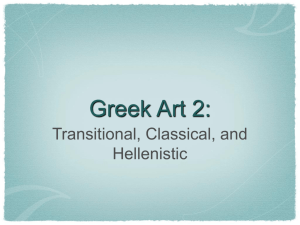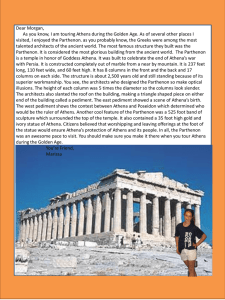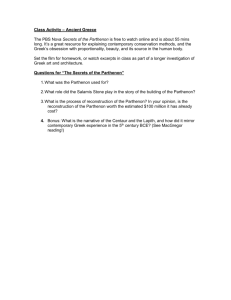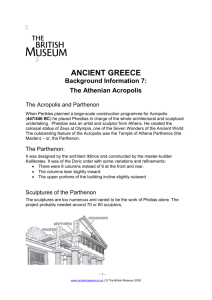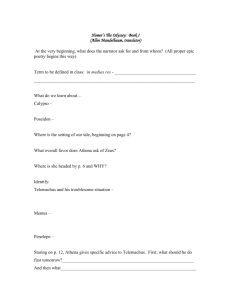Parthenon-Spring12 - arthumanities
advertisement
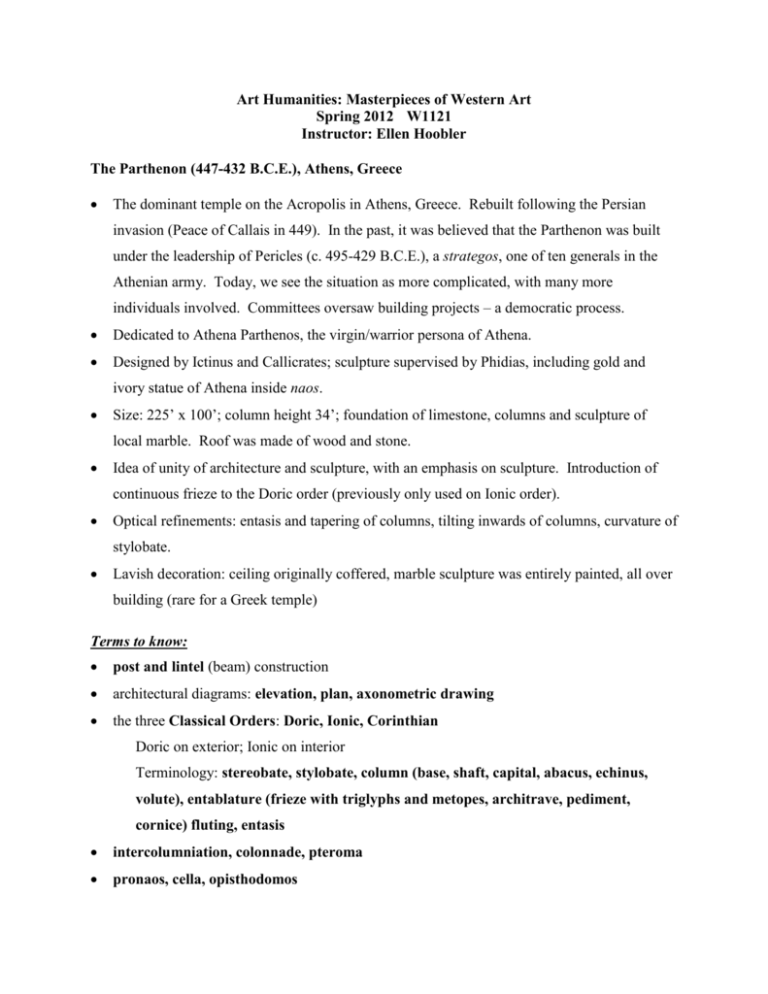
Art Humanities: Masterpieces of Western Art Spring 2012 W1121 Instructor: Ellen Hoobler The Parthenon (447-432 B.C.E.), Athens, Greece The dominant temple on the Acropolis in Athens, Greece. Rebuilt following the Persian invasion (Peace of Callais in 449). In the past, it was believed that the Parthenon was built under the leadership of Pericles (c. 495-429 B.C.E.), a strategos, one of ten generals in the Athenian army. Today, we see the situation as more complicated, with many more individuals involved. Committees oversaw building projects – a democratic process. Dedicated to Athena Parthenos, the virgin/warrior persona of Athena. Designed by Ictinus and Callicrates; sculpture supervised by Phidias, including gold and ivory statue of Athena inside naos. Size: 225’ x 100’; column height 34’; foundation of limestone, columns and sculpture of local marble. Roof was made of wood and stone. Idea of unity of architecture and sculpture, with an emphasis on sculpture. Introduction of continuous frieze to the Doric order (previously only used on Ionic order). Optical refinements: entasis and tapering of columns, tilting inwards of columns, curvature of stylobate. Lavish decoration: ceiling originally coffered, marble sculpture was entirely painted, all over building (rare for a Greek temple) Terms to know: post and lintel (beam) construction architectural diagrams: elevation, plan, axonometric drawing the three Classical Orders: Doric, Ionic, Corinthian Doric on exterior; Ionic on interior Terminology: stereobate, stylobate, column (base, shaft, capital, abacus, echinus, volute), entablature (frieze with triglyphs and metopes, architrave, pediment, cornice) fluting, entasis intercolumniation, colonnade, pteroma pronaos, cella, opisthodomos Art Humanities: Masterpieces of Western Art Spring 2012 W1121 Section 026 Instructor: Ellen Hoobler The Parthenon (447-432 B.C.E.), Athens, Greece: Sculpture / Parthenon History Sculptural program Outer frieze: Lapiths (Greeks) and Centaurs on south metopes. High relief. Pediments. Sculpture in the round. o East: Birth of Athena. o West: Contest between Athena and Poseidon. Inner frieze: Panathenaic Procession. Low (or bas-) relief. Not part of original plan, added after construction underway. Most important part of decoration. Statue of Athena Parthenos in naos; made of gold and ivory (chryselephantine) The Parthenon through history Converted into a church dedicated to the Virgin Mary throughout the Middle Ages. Converted into a mosque at the end of the 15th century and used through the beginning of the 19th century. 1687: Building blown up by Venetian mortar hitting Turkish powder magazine stored in building. Only the east and west ends remained; restoration efforts began soon after. Thomas Bruce, Lord of Elgin and British ambassador to Turkey, received permission from sultan to remove sculptures from building in early 1800s. In 1806, he took them back to London, and in 1816, he sold them to the British Museum. Comparisons Temple of Hera I (Basilica) at Paestum, c. 540 B.C.E. Parthenon in Nashville, TN, built in 1895 for Centenary Exposition Resources Bruno, Vincent J, ed. The Parthenon. N.Y.: W.W. Norton & Co., 1974. Hurwit, Jeffrey M. The Acropolis in the Age of Pericles. Cambridge: Cambridge University Press, 2004. Pollitt, J.J. Art and Experience in Classical Greece. Cambridge: Cambridge University Press, 1972. Chapter 3: “The World Under Control,” pp. 64-110.
